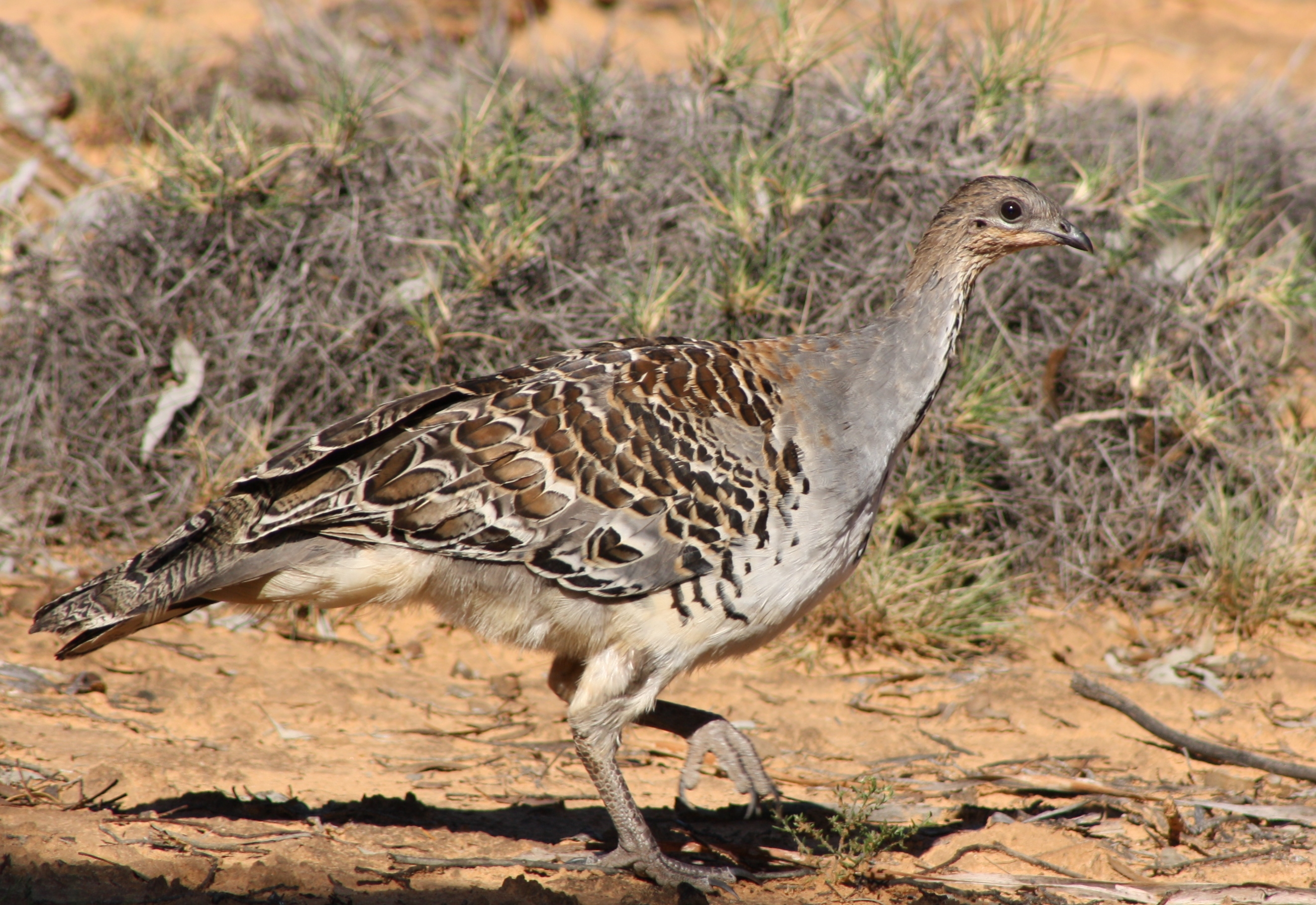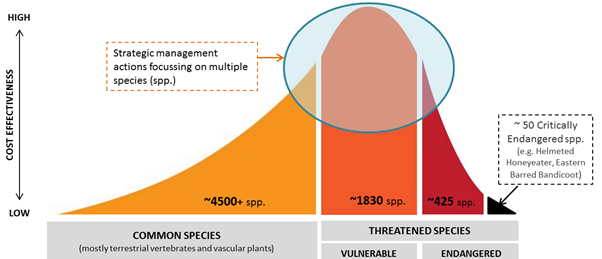A background on Victoria's threatened species
Victoria is the most intensively settled and cleared state in Australia. Much of it has been altered for farming and other human activities.
The decline in the amount and quality of habitat has had major impacts on Victoria’s plants and animals. Since European settlement, Victoria has lost 18 species of mammal, 2 birds, 1 snake, 3 freshwater fish, 6 invertebrates and 51 plants. Today, between one quarter and one third of Victoria’s terrestrial plants, birds, reptiles, amphibians and mammals, and many invertebrates and ecological communities, are at risk of extinction.
 Malleefowl. Photo Credit: Marcia Riederer
Malleefowl. Photo Credit: Marcia Riederer
Ongoing threats continue to place our ecological communities at risk of further decline or extinction. Some of these threats include:
- Changes to fire frequency and intensity
- Invasive plants and animals
- Habitat loss and fragmentation
- Changes to riverflows, wetlands and floodplains
Victoria has a large and growing number of threatened species and communities. Climate change and population growth are expected to exacerbate existing threats and bring new challenges for Victoria’s biodiversity.
We are investing in the recovery and management of threatened species and communities. All sectors of the community are engaged in programs to improve the outlook for our native plants and animals. Works being undertaken include:
- Revegetation on public and private land from the coasts to the alps
- Connecting habitat with corridors
- Surveying and controlling invasive species like foxes and Northern Pacific Seastars
- Restoring environmental flows
- Creating ‘insurance populations’ of threatened species, preserving plants in seed banks and rearing animals in safety for future release into the wild (captive breeding).
We are working to strengthen leadership and accountability and improve strategic biodiversity planning. Working in partnership with the community will continue to be an integral part of this journey.
Protecting Victoria's Environment - Biodiversity 2037 (biodiversity plan) was released in 2017. The plan shifts our approach from planning for individual threatened species and towards broader scale threat management.
This approach benefits many species. It provides a preventative approach, reducing the risk of species becoming more threatened. Broader scale actions that focus on many species can prevent many vulnerable and common species from becoming endangered. It can also provide co-benefits to endangered and near-threatened species. As a result, these actions can be much more cost-effective.
Some endangered and critically endangered species will not benefit from this approach and will need specialised interventions. Specific threat management to meet the unique needs of individual species or situations will be balanced against what can be achieved for other species.
Visit the Protecting Victoria's Environment - Biodiversity 2037 page to learn more.
Figure 1: A conceptual model of the new approach. Long term, whole of Victoria, and selecting an efficient suite of actions that benefit the most species (Biodiversity Plan 2037).

We're developing a range of tools for decision-makers to plan to benefit the greatest number of species.
- NaturePrint is a suite of decision-support tools designed to help us make choices about what actions to take and where to protect Victoria’s environment and plan for the future.
- The Strategic Management Prospects is a valuable tool for guiding decisions around threatened species as it helps biodiversity managers to identify and prioritise management options in a transparent, objective and repeatable way.
Establishing a cost-benefit framework is a priority task in the biodiversity plan.
It will help us better understand the cost-effectiveness of appropriate management interventions and improve decision making and investment in the conservation of endangered and critically endangered species.
The framework is being developed with a focus on those species which are more likely to need some form of direct intervention, because they won't typically respond well to landscape-scale management. In this way, the framework will complement the Strategic Management Prospects tool. The tool provides guidance on the relative benefit of a range of more typical landscape-scale interventions for multiple species at locations across Victoria.
The framework will provide a recommended decision flow chart, linked to information products and decision support tools and processes. The framework will be able to be updated as new information and tools become available. It will help users to make the best use of information and tools at the appropriate stage of thinking, planning and project implementation or review.
An anticipated outcome of the biodiversity plan is that a conservation option, either ex situ (off-site) or re-establishment in the wild, will be identified for each critically endangered or endangered species.
This project involves a review of current approaches to the use of translocation and various forms of gene mixing for threatened species conservation. In part, with a view to using these direct conservation interventions to a greater extent, because of changing climate and challenges that it presents for some endangered species.
Case studies will showcase innovative examples of conservation management measures used to improve knowledge of applications and critical decision points. This project will also review current policies and procedures to determine changes needed to support improved conservation outcomes into the future.
Victoria has reviewed laws and rules protecting threatened forest species and communities. The review also looked at ways to strengthen or improve these laws.
The Regional Forest Agreements review was completed in December 2022.
Final Report - Threatened Species and Communities Legislative Review (PDF, 1.5MB)
Final Report - Threatened Species and Communities Legislative Review (DOCX, 5MB)
The review found no major changes are needed to the laws that protect these species and communities, but further work can be done in how these laws are implemented.
DEECA is looking at ways to put the review's proposals into action. This review builds on other work which includes:
- Independent Review of Timber Harvesting Regulation (2018)
- Review of the Flora and Fauna Guarantee Act 1988
- Forests Legislation Amendment (Compliance and Enforcement) Act 2021
- 2021 and 2022 Variation of the Code of Practice for Timber Production 2014
- Comprehensive Adequate and Representative (CAR) Reserve Review
- Victorian RFA Major Event Review of the 2019/20 bushfires
- Threatened Species and Communities Risk Assessments – interim and permanent protections
- Review of the Wildlife Act 1975
- Comprehensive Review of the Code of Practice for Timber Production 2014
DEECA provides a range of funding opportunities to community groups and others to undertake conservation actions that deliver the most benefit for the most species.
You can search our listing of grants and assistance offered through DEECA, including threatened species initiatives, through the following pathways:
Who are our key partners?
Community involvement is an important part of managing the state’s environment. We aim to build lasting partnerships to help address the challenges of threatened species conservation.
We collaborate with a broad range of partners and stakeholders across Victoria to develop policy and implement on-ground actions.
- Australian Government Department of Climate Change, Energy, the Environment and Water
- Statutory authorities, such as Parks Victoria, Melbourne Water, Environment Protection Authority and catchment management authorities
- State government agencies, including Department of Transport and Department of Jobs, Precincts and Regions
- Local government
- Industry groups, such as the Victorian Association of Forest Industries
- Recovery teams
- Education providers, including Zoos Victoria, Royal Botanic Gardens Victoria and Museums Victoria
- Non-government bodies, including Australian Conservation Foundation, Environment Defender’s Office, Victorian National Parks Association, Greening Australia and Trust for Nature
- Traditional Owners and Aboriginal Victorians
- Community groups, including Conservation Volunteers Australia, Victorian Environment Friends Network, Landcare Victoria, Field Naturalists Club of Victoria and Birdlife Australia
- Landowners
- Scientific community
- General community
Page last updated: 29/12/23